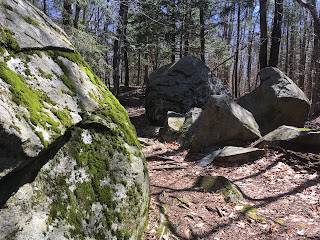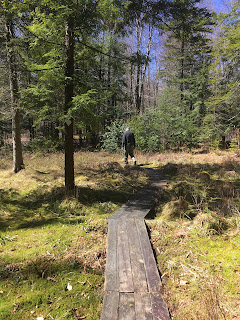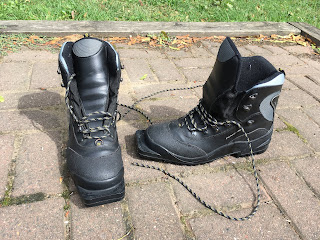Some of you know that I don't look forward to July, with its notorious heat and humidity. Although June and August can also have unbearable days, it's refreshing to look back at my ongoing series of local hikes in May and June's cooler temperatures.
 |
| (The Sentinels, rocks at Dyken Pond) |
 |
| (a board walk covers a swampy area of trail) |
In early May, Bill and I headed to Dyken Pond Environmental Education Center in the Rensselaer Plateau. Trails spread out from a small parking lot in every direction, covering over thirty-three ecological communities
ranging from beech-maple forests to spruce-fir swamps, beaver ponds and
vernal pools. I especially like the large rocks here, which remind me of the Druid gardens at Blarney Castle in Ireland.
 |
| (Dyken Pond) |
At the end of our walk, we sat by Dyken Pond and enjoyed a snack.
I was shocked to discover that the sole of one of my hiking boots had become detached from the shoe! I was glad that I hadn't tripped on the flapping sole. Although these are my "local hikes" boots, easily 10 years old and having been retired from more strenuous hiking, I would not consider replacing them during this COVID period when mail order was the only shopping option.
 |
| (Uh-oh) |
On a mid-week day, my friend, Karen, and I decided to explore the Keleher Preserve, a Mohawk-Hudson Land Conservancy property close to home in the Helderberg Escarpment.
Between the gift of land in 2010 and a later purchase, the Keleher Preserve comprises 447 acres, but so far has only 4 miles of trails. I am so appreciative when people donate their large rural properties for ongoing preservation. This land in Voorheesville could easily have become a housing development.
I was ready for our hike, having duct-taped my boot back together.
 |
| (Great signage at the Keleher Preserve) |
Along ravines and through hard wood forests, the well-marked paths lead to a bench and overlook across the valley to the northeast -- a perfect spot to stop for a snack. Early spring-green leaves just began to lend a chartreuse haze across the forest as sun filtering through the trees created a picturesque dappled floor.
On our next available weekend, Bill and I drove over to the Boulders in Dalton, Massachusetts, just
beyond "hiking local," but still not far from our Albany home. When a friend, who is on the Berkshire Natural Resources Council Board (BNRC), highly
recommended visiting The Boulders, I put it on my list. There are 6 miles of trails on its 645 acres. This extensive preserve belonged to Crane and Company, makers of paper used for U.S. currency. In 2015, the Crane family donated the land to BNRC.
 |
| (the Reservoir at The Boulders) |
A woodland trail took us by a small pond, vernal pools, and damp woods where marsh marigolds bloomed. Again, a modest view could be seen through the trees. At first, I thought these trails would lend themselves perfectly to cross-country skiing, but then decided that snowshoes would be safer on some of the narrow curving down-hill runs. Regardless, winter would be a good time to return.
 |
| (The Boulders) |
Bill and I began June with a perennial favorite, the Huyck Preserve in Rensselaerville. The Huyck Preserve has lower trails climbing from the parking area along the impressive Tenmile Creek Rensselaerville Waterfall and around Lake Myosotis. The newer upper trails, that opened to the public in 2012, edge creeks, rise over hills and criss-cross the stonewalls of long ago farms.
 |
| (Lake Myosotis) |
I regularly lead Adirondack Mountain Club trips to the Huyck Preserve in any season, and have visited many times with friends and family. With over 2000 acres and more than 12 miles of trails, this preserve also includes one of the oldest biological research stations
in the United States and has supported research continuously since 1938.
 |
| (Narrow bridge across a wet area) |
My friend, Karen, and I drove into Rensselaer County to explore the Kinderhook Preserve on a sultry morning. Neither of us had previously been to this small 85-acre Rensselaer Land Trust property with its five miles of trails. A half-mile trail goes along the edge of Kinderhook Creek where sandy beaches looked inviting for a swim. Other trails border rock cliffs and lead up and down ravines, adding a lot of interest to this outing. Karen and I hiked the perimeter trail first and then the interior trails.
Again, I considered whether the wide trails would be a good XC ski spot, until we reached the steep ravines. Definitely, snowshoes only! One section even had a climbing rope to aid hikers.
 |
| (Kinderhook Creek) |
The Kinderhook Creek Preserve is built around the concept of a “working
forest” which includes ecological and environmental
protection, outdoor recreation, timber production using sustainable
forest management practices, wildlife habitat enhancement, and nature study.
 |
| (Steep terrain abounds at the Kinderhook Preserve) |
By mid-June, lush green was everywhere. My friend, Linda, and I went back to a long-time favorite, Thacher Park. It is notable in this blog post that friends became a larger part of my local hiking experience than previously, although Bill and I were still getting out on weekends as well.
On this day, Linda and I drove separately, not yet comfortable with sharing a car ride. We hiked at a social distance and had our masks at the ready, should we meet other hikers. Incidence of COVID-19 had become extremely low in our Capital Region, but we still took precautions.
 |
| (View to Albany from High Point at Thacher North) |
We chose to hike the Fred Schroeder Memorial Trail in Thacher North. Besides leaving a huge volunteer hiking legacy introducing hundreds of underprivileged children to the Adirondacks, Fred Schroeder led weekly hikes for the Adirondack Mountain Club for 30 years. This trail, near his home, was designated a memorial to him after his death in 2010.
Besides its testament to the accomplishments of Fred Schroeder, the trail includes the end point of the Long Path, a 357-mile long-distance hiking trail beginning
at the George Washington Bridge in Fort Lee, New Jersey and ending here.
Linda and I found a shady spot at High Point Cliff for a snack and visit, facing spectacular views. And to top it off, I had new boots! Thanks to LLBean re-opening, I was able to try boots on and found these that should be perfect for half-day local outings. My old taped-together boots went in the trash.
 |
| (LLBean Alpine Hiking Boots) |
While all these local preserves and parks are wonderful, I longed for the Adirondacks with its wild character and majestic views. I was open to going to any part of the Adirondack Park -- the Lake George area, the high peaks, Indian Lake, anywhere! But the hostels I liked were closed and campgrounds were not open for new reservations or walk-ins.
 |
| (Evening view with Heart Lake from Mt. Jo) |
As Outings Chair for the Albany Chapter of the Adirondack Mountain Club (ADK), I receive regular updates from the Club's main office. When an email arrived stating that the ADK-owned campground at Heart Lake, nestled in the high peaks would open at 50% capacity, I knew I had found my destination! With just half of the 31 tent sites open for use, this campground fit my bill.
 |
| (Evening and a swim at Heart Lake) |
What a treat to go to a place I loved for a short camping and hiking trip. Taking my "serious hikes" boots along for this trip, I rationalized that it was okay to break away from the Department of Environmental Conservation recommendations to "stay home" and "hike local" just this once.
 |
| (Asolo hiking boots, some of the most comfortable I have ever owned) |
A chilly June spell was just beginning to change into a heat wave, but I squeezed in an evening hike up Mount Jo and a day hike to Phelps Mountain, with a swim after each. Camping at Heart Lake was a wonderful break in this COVID period. And there would be more beautiful local places to explore close to home upon my return -- once the heat wave passed.
 |
| (Phelps Mtn. is #32 of the 46 Adirondack High Peaks. For my third time hiking this mountain, I was rewarded with the best views I had ever had there.) |
































